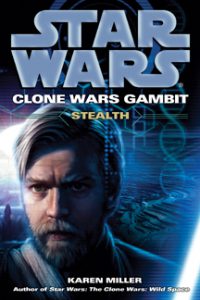As she did on “Clone Wars: Wild Space,” Karen Miller again shows she’s a master of delving into characters’ headspaces in “Clone Wars Gambit: Stealth” (2010), the first of a duology that concludes with “Siege.” You won’t get complex plotting here, but you do end up with a thorough grasp of the physical and psychological stresses put on Obi-Wan and Anakin on a mission to Lanteeb, where Separatist General Lok Durd (the fat Neimoidian voiced by George Takei on the TV show) is overseeing the creation of a bioweapon.
Because it’s meant to give us a deeper sense of the characters’ thoughts and emotions, “Stealth” isn’t an essential novel in terms of the wider plot of the Clone Wars. But it does deliver a few notable insights and oddities.
First, I’ll cite a throwaway line that meant a lot to me. On page 335, Bail Organa, conversing with Yoda, thinks to himself:
They lived so simply, it was easy to forget that over the generations the Jedi had amassed vast wealth. Which was understandable – the Temple and its widespread activities were enormously expensive to maintain, and the Order received no Republic funding.
Throughout my re-read (particularly when Luke’s Order and the New Republic clash in the post-“ROTJ” novels), I’d wondered how the Jedi Order is funded, and my analysis of the Jedi-Republic relationship was colored by my assumption that they received some tax funding. This is indeed the assumption among most fans, but Miller directly shoots that down here (at least for the Legends timeline). But she also raises another huge question: How in the world did they amass vast wealth? Wise investments? Donations? Using the Force to cheat at gambling?
Wookieepedia’s entry on the Jedi Order includes no subsection on funding, and most internet discussions of the topic are colored by the assumption that the Order DOES receive government funding.
The second oddity: Lok Durd has escaped from Republic custody between his capture in Season 1’s “Defenders of Peace” (surprisingly, his only appearance on the show) and this book. The story of his escape is never told – indeed, Wookieepedia uses the throw-up-your-hands phrase “Durd somehow managed to escape Republic custody,” confirming that this mystery isn’t resolved in “Siege.” What’s even weirder is that Durd’s appearance is a surprise to Obi-Wan and Anakin, meaning that the Jedi Council never informed them of Durd’s escape.
On page 320, Obi-Wan converses with Yoda via holotransmission from Lanteeb:
Obi-Wan: “Lok Durd’s behind this. Yoda, did you know he’d –”
Yoda: “Know that I did, Master Kenobi. Matter now it does not. More of this bioweapon tell me.”
A third oddity of “Stealth” is that it introduces Taria Damsin, a former love interest of Obi-Wan. On my first read, I assumed this was a character from the “Jedi Apprentice” junior-reader novels, which I have not read. However, the character I was thinking of is Siri. Taria is totally new to this book. Throw in Satine from “The Clone Wars” TV series, and it’s becoming obvious that Obi-Wan flouts the Jedi Code even worse than Anakin does – which seems dishonest, and which is arguably out of character.

(Yes, Obi-Wan is known for bending the truth, but that’s later on the timeline. Along those lines, Miller is interested in exploring how Obi-Wan develops that sly “certain point of view” streak, and posits an answer here. Yoda instructs Obi-Wan to lie to the Separatists’ captive scientist, Ban’tena, telling her the Republic has rescued all of her loved ones held hostage, even though one is unaccounted for. To Anakin’s shock, Obi-Wan agrees to lie, echoing Yoda’s argument that it’s a wartime necessity.)
Despite popping up out of nowhere, Damsin is a pretty good character. In addition to being a rare “Star Wars” hero who is dying of a terminal disease, I like how she serves as a mentor and friend to Ahsoka, teaching her restraint to balance out Anakin’s headstrong style. I almost wanted to hug Ahsoka when on page 274, she thinks:
It occurred to Ahsoka then that the Jedi Master was teasing her, bantering with her the way Skyguy and Master Kenobi bantered with each other because they were friends. Does that mean Taria and I are friends? Is that how easily it happens?
The biggest takeaway from “Stealth” is that the Clone Wars are not fun and games, an impression one might get from the TV show, which is fun to watch and often quippy. Rather, war is horrific; this book may spring from the cartoon, but it’s as “adult” as “Star Wars” novels come.
Anakin chafes at the clandestine mission, he and Obi-Wan are hungry and their Force reserves are nearly sapped. They’re still stuck on Lanteeb at book’s end. Durd is a violent sociopath of a villain who physically beats Bant’ena in addition to threatening her loved ones. The Separatists are not merely an alternate option for planetary governments to join, but rather an organization that violently takes over planets. On Lanteeb, Anakin and Obi-Wan encounter bombed-out buildings filled with corpses. The Seps hold some citizens as slave labor, but mostly they are content to bomb them to death.
“Stealth” is not always pleasant reading – and it’s never brisk reading — but it’s always good reading. Miller delivers clean prose and a good understanding of all the characters. I was impatient with her writing the first time around, but since the cancellation of the EU, I’m happy to spend more time with her dense novels.

